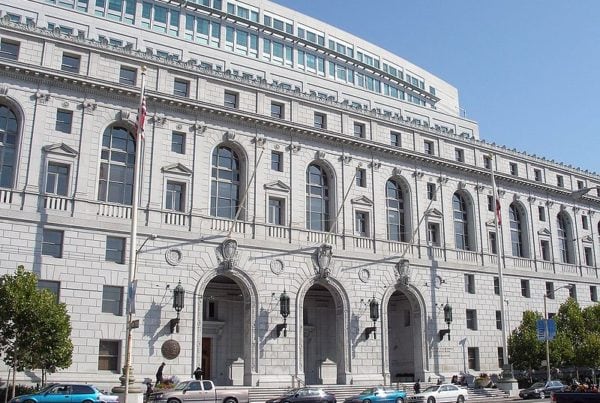A split Ninth Circuit panel affirmed on Nov. 18 the San Bernardino International Airport’s air cargo facility development, denying petitions filed by the San Bernardino nonprofit Center for Community Action and Environmental Justice, the Sierra Club, local Teamsters and the state of California, which said the project’s required environmental assessment was inadequate and needed a review.
The Federal Aviation Administration’s Dec. 23, 2019 Record of Decision found no significant environmental impact in the construction and use of an air cargo facility at the airport.
Judge Johnnie Rawlinson said the project was improperly vetted, “reeked of environmental racism,” and would never be proposed near Jeff Bezos’ home.
The project, the Eastgate Air Cargo Facility, will be a 658,500-square foot sort, distribution and office building with 101 dock doors and 20 air cargo container doors, two 25,000-square foot maintenance buildings and 2,000 parking spots, according to the Record of Decision. It will generate 24 daily take-offs and landings, 192 daily roundtrip truck trips and 3,486 daily passenger car trips in its first year of operation, according to the panel’s dissenting opinion.
Former California Attorney General Xavier Becerra joined the petition to claim that the project was improperly started without a necessary environmental impact report.
Nonprofit’s arguments
The Center for Community Action and Environmental Justice, represented by Earthjustice, took issue with the analysis on four grounds:
1) That the FAA based its environmental review on baselines that conflicted with the National Environmental Policy Act (NEPA) and the FAA’s own regulations
2) That the analysis ignored projects related to the cargo facility that may have an environmental impact if taken together, violating NEPA and 40 C.F.R. § 1508.27(b)(7)
3) That the FAA understated the number of truck trips associated with the project, by stating there would be 192 truck trips in their environmental analysis, but 3,823 daily trips in the first year of operations according to a separate document
4) That the FAA didn’t examine the project’s impacts to air quality and climate, in contradiction of NEPA and 40 C.F.R. § 1508.27(b)(10)
Appellate ruling
The appellate court found the Center’s first argument faulty, and called the regulation cited by the Center, the FAA’s 1050.1F Desk Reference, guidance without the weight of law.
“This Desk Reference may be cited only as a reference for the guidance it contains, and may not be cited as the source of requirements under laws, regulations, Executive Orders, DOT or FAA directives, or other authorities,” the introduction reads.
The Center failed to prove the environmental assessment’s nonadherence to the Desk Reference had any significance, the panel ruled.
On the Center’s second claim on cumulative project impacts, the panel found that the FAA did consider cumulative projects, but the Center erroneously read case precedent that led them to believe specific, quantifiable data about cumulative projects was required.
On the Center’s third claim on truck trips, the panel found there was no authority to demand the FAA be consistent on their anticipated number of truck trips between documents and that the Center provided no reason to believe the environmental assessment’s number was inaccurate.
On the Center’s final claim on climate and air quality standards, the panel found that the Center did not articulate a violation of the California Clean Air Act.
State’s argument
Former California Attorney General Xavier Becerra filed his petition to review the project’s analysis, arguing that the San Bernardino International Airport Authority and the FAA were required under NEPA to create an environmental impact statement, in addition to their environmental assessment, because the Airport Authority’s Final Environmental Impact Report found the project would have significant and unavoidable impacts on the environment.
The panel found that the South Coast Air Quality Management District labeled the project as complying with federal and state air quality standards, and that the state did not raise a substantial question as to whether the expansion may have a significant effect on the environment as to require an environmental impact statement.
Dissenting opinion
California’s environmental impact report — which concluded that operation of the project would result in “significant impacts” on air quality, greenhouse gases and noise — casts doubt that the FAA took the required “hard look” at the project as required, wrote Judge Johnnie Rawlinson in a dissenting opinion.
The study area for air quality was too small, encompassing only 11 square miles instead of the entire geographic area, including the area around truck routes, which could be indirectly affected by the project, Rawlinson found. This finding also means that the cumulative-effects analysis is similarly flawed, Rawlinson wrote.
Finally, the FAA arbitrarily used two different truck-trips figures and did not provide an analysis of roundtrip emissions, Rawlinson wrote.
Rawlinson said the project was improperly vetted, “reeked of environmental racism,” and would never be proposed near Jeff Bezos’ home.
“The same standard should apply to the residents of San Bernardino Valley, who have already borne for many years the heavy cost of pollution resulting in a quantifiable detriment to their health. But such is the nature of environmental racism,” Rawlinson wrote.
Parties
Adrian Martinez, Yasmine Agelidis and Gregory Muren, lawyers for Earthjustice, represented the Center for Community Action and Environmental Justice, the Sierra Club, Teamsters Local 1932 and Highland residents Shana Saters and Martha Romero in their June 30, 2020 petition. Martinez argued in front of the panel.
Xavier Becerra, California attorney general; Harrison Pollak, acting senior assistant attorney general; Christie Vosburg, supervising deputy attorney general; and Yuting Chi, deputy attorney general, submitted California’s Feb. 20, 2020 petition. Chi argued in front of the panel.
Rebecca Jaffe, attorney, argued for the FAA, with assistance from attorneys Justin Heminger and John Arbab; Eric Grant, deputy assistant attorney general and Jonathan Brightbill, principal deputy assistant attorney general, of the Environment and Natural Resources Division of the United States Department of Justice, and Joseph Manalili, senior attorney in the office of the chief counsel of the Federal Aviation Administration.
Michael Carroll, of Costa Mesa’s Latham & Watkins, argued for intervenor and developer Eastgate Bldg. 1, LLC, and Ronald Scholar, of Roseville’s Cole Huber LLP, argued for intervenor San Bernardino International Airport Authority.
Circuit Judge Eugene Siler wrote the majority opinion, Patrick Bumatay concurred and Johnnie Rawlinson dissented.
Read the decision here.
Read the nonprofit’s petition here.
Read the state’s petition here.
[/wlm_private]







